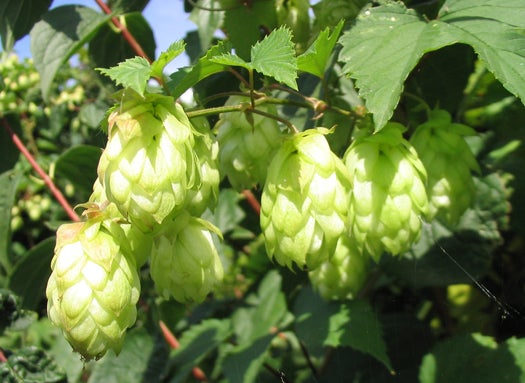BeerSci: Are Hops Addictive?
It certainly looks that way if you hang around beer people.


Beersci Logo
Modern-day hopheads–the beer drinkers who gleefully, obsessively seek out hoppier and hoppier brews–don’t usually start out that way. Most people have a natural aversion to bitter compounds–useful for avoiding eating lethal doses of poisons in the wild. No, one must work one’s way up to hops: Start off drinking beers with lower IBUs (International Bitterness Units, one measure of how bitter a beer is), be them ambers, lagers, brown ales, or stouts. Next, try a pale ale. Then try many pale ales. Then discover the IPA — and with it, become obsessed with hop varietals such as Simcoe (piney aroma) and Amarillo (fruity aroma). Be happy with that for a while. Maybe try a double IPA (twice the malt, twice the hops as a regular IPA), which may or may not be successful, depending on whose you drink. Begin to love being punched in the face with a fist of hops. Become obsessed with IBU ratings. Buy the hoppiest beers one can find, even if they don’t actually taste all that good. Despair.
Back in 2005, a pair of California-based brewers (Vinnie Cilurzo of Russian River and Matt Brynildson of Firestone Walker) came up with a tongue-in-cheek definition for this hop passion. They called it the lupulin threshold shift, describing it as “when a double IPA just isn’t enough.” (Lupulin glands on the hop cones hold the main hop compounds that eventually contribute flavor and bitterness to beers.) I’ve seen many a beer drinker ask why they feel compelled to seek out ever-hoppier beers. Could it be that their brains and tastebuds are addicted to the hop?

Hops
While pushing the hop envelope — and one’s tastebuds — is an escalating practice, are hops actually addictive? The answer is no. You can cut hops out of your diet with no adverse physical reactions just like you can do the same for curry or bacon cheeseburgers or any number of other food items for which one occasionally develops cravings. Gustatory cravings are not the same as caffeine jags, nic fits or heroin jones. Although recent research seems to suggest that certain “psychological” addictions might be more similar to physical addictions than previously thought, the mechanism of opiate or nicotine addiction is generally quite different on a molecular level. Let’s look, for example, at nicotine. The nicotine molecule binds to receptors in the brain called nicotinic acetylcholine receptors. When those receptors activate, dopamine accumulates in certain parts of the brain, which either directly or indirectly signals reward or reward expectation. Frustrated reward kicks off another biochemical pathway leading to the physical effects of withdrawal. Re-addition of the chemical quells the withdrawal, reinforcing the physical addiction. With something like a food addiction (aka compulsive overeating), the initial chemical event — e.g. the binding of nicotine to a nicotinic receptor — is absent. That said, a dopamine reward mechanism is still triggered, which reinforces the behavior. Further, recent research shows that compulsion — frequently thought to be only a hallmark of the so-called psychological addictions — actually plays a role in physical addictions as well. So, while you might be getting addicted to the alcohol in beer (another physical addiction), you’re not ever going to become physically dependent on humulones.
So, what’s going on with the whole hop-escalation thing, then? I’ve seen some scientists suggest that the culprit is sensory adaptation and habituation. Adaptation occurs when your perception of taste or smell dissipates over the course of exposure to the sensation. Adaptation happens quickly, usually over a few minutes, and reverts to the normal sensitivity within an hour or so. Habituation, on the other hand, means that for a long time after the initial exposure, sensitivity to the sensation remains diminished. Research indicates, for example, that capsaicin exposure has both an adaptation element (the heat in that salsa will only be bad for about 15 minutes), and a habituation element (for about a week afterward, that salsa will remain less “hot” to the test subject, which scientists suspect is why some people can tolerate much hotter foods than others).
I’ve found a fair bit of research out there on both bitter taste habituation and olfactory habituation; both kinds are important when dealing with hops, since “hoppiness” is really a mixture of an aroma experience and a bitter taste experience. In the case of olfactory adaptation and habituation, the mechanisms of change appear to be quite different. In a paper published in 2010, for example, the quick adaptation occurred mostly due to synaptic adaptation in the brain’s cortex. With the long-term habituation, on the other hand, related changes occurred in the olfactory bulb rather than the brain. Anyway, so while I haven’t seen much literature on hop bitterness and aroma adaptation and/or habituation, I wouldn’t be surprised if there was an element to both driving the desire to drink 1,000-IBU** beers.
**It is not technically possible to brew a 1,000-IBU beer, but that doesn’t stop brewers from engaging in a bit of exaggerated labeling.